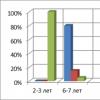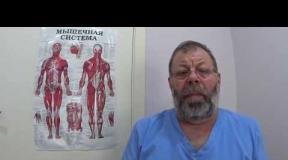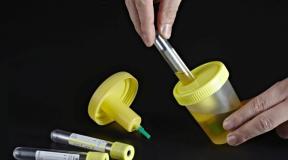Medicinal reference book geotar. Promedol - description of the drug, instructions for use, reviews Promedol side
Promedol is an analgesic with a powerful analgesic effect.
Active substance
Trimeperidine
Release form and composition
Available in the form of a solution for injection and tablets. The main active ingredient is trimeperidine.
Indications for use
In surgery:
- local anesthesia before surgery and in postoperative period, with injuries and fractures to prevent the onset of pain shock;
- with inoperable malignant neoplasms to alleviate the patient's condition.
In therapy:
- dyskinetic constipation;
- peptic ulcer;
- angina pectoris;
- cholecystitis;
- intestinal / renal colic.
In obstetrics, this drug is used as a pain reliever and birth control.
In neurology, it is used to relieve pain in the following pathologies:
- thalamic syndrome;
- causalgia;
- neuritis;
- severe sciatica;
- protrusion of the intervertebral disc.
In cardiology: withdrawal pain with thrombosis of the great vessels, myocardial infarction, etc.
In oncology: relief of conditions of cancer patients.
Contraindications
- individual intolerance to trimeperidine;
- oppression of the respiratory center;
- conducting epidural or spinal anesthesia in the presence of bleeding disorders;
- simultaneously with MAO inhibitors used to treat diseases of the central nervous system;
- high blood pressure;
- bronchial asthma;
- oppression nervous system;
- heart rhythm disturbances.
It is used extremely rarely and with extreme caution in renal / hepatic insufficiency, in old and childhood.
Instructions for use Promedol (method and dosage)
Pills. To relieve pain, it is usually prescribed to adult patients in doses from 25 mg to 50 mg. Maximum daily dose equals - 50 mg.
Injection. For the purpose of premedication, and 30-40 minutes before surgery, 20-30 mg intramuscularly or subcutaneously is administered in combination with Atropine 0.5 mg.
During childbirth, intramuscular or subcutaneous administration is prescribed in doses of 20-40 mg, with a positive assessment of the condition of the fetus and the dilatation of the cervix by 3-4 cm. The last injection should be made 30-60 minutes before the expected delivery.
- The maximum parenteral dose for adults is 40 mg, and the maximum daily dose is 160 mg.
- For children over 2 years old, the dose is 0.1 - 0.5 mg / kg, with s / c, i / m and rarely i / v. Repeated injections, in order to relieve pain, can be carried out after 4-6 hours.
When carrying out general anesthesia, intravenous injection is administered at 0.5-2.0 mg / kg / hour. The maximum dose, during the entire time of the operation, should be no more than 2 mg / kg / hour.
Intravenous administration indicated only in emergency cases for the relief of severe pain in trauma.
Side effects
Some reviews report that while taking Promedol, sometimes such side effects appear:
- allergic reactions;
- phenomena on the part of the circulatory system (heart rhythm disturbance, instability of blood pressure) and respiratory organs (hypoxia, respiratory depression);
- nausea, vomiting, dry mouth;
- constipation;
- drowsiness, condition general weakness, dizziness;
- nervousness;
- convulsions;
- confusion or euphoria.
Overdose
Overdose symptoms of Promedol:
- miosis;
- oppression of consciousness;
- increased severity of side effects.
Treatment: maintaining adequate pulmonary ventilation, symptomatic therapy. Intravenous administration of a specific opioid antagonist naloxone at a dose of 0.4-2 mg quickly restores breathing. If there is no effect after 2-3 minutes, the introduction of naloxone is repeated.
Analogs
Analogs according to the ATX code: Promedola solution for injection.
Do not make the decision to change the drug yourself, consult your doctor.
pharmachologic effect
The action of Promedol is to activate the endogenous antinociceptive system, due to which the transmission of pain impulses between neurons at different levels of the central nervous system is disrupted. He is also able to influence the higher parts of the brain, changing the emotional color of pain.
Trimeperidine, basic active substance, has the following effects on the body:
- increases the threshold of pain sensitivity;
- acts as a mild hypnotic and sedative;
- inhibits conditioned reflexes;
- in the process of labor, it stimulates the opening of the cervix, tones up and increases the contractile activity of the myometrium.
The analgesic effect of the drug after parenteral administration occurs after 15-20 minutes and lasts for 2-4 hours, however, when used for epidural anesthesia during childbirth, its effect lasts up to 6-8 hours.
special instructions
- It can only be prescribed by the attending physician, self-medication in this case is not permissible. Also, the attending physician prescribes the duration of the course of treatment and the dosage.
- Given the fact that drugs are addictive, psychological and physical dependence, it is prescribed only when urgently needed. To alleviate the conditions of patients, a course of treatment is prescribed as long as possible.
- For the period of treatment, various activities should be abandoned, during which a quick reaction or increased concentration of attention is required. Also, during the period of treatment, the use of any alcoholic beverages (including low-alcohol ones) is strictly prohibited.
- Since the drug belongs to drugs from the group of "narcotic analgesics", it is allowed to use it only under the constant supervision of a doctor.
During pregnancy and breastfeeding
It is used during childbirth according to indications.
In childhood
Contraindicated in children under 2 years of age. It is used with extreme caution in children over 2 years of age.
In old age
It is used with extreme caution in the elderly.
Drug interactions
Barbiturates reduce the effectiveness of the analgesic. Nalophrine relieves respiratory depression, which is provoked by opioid analgesics, while not reducing their effectiveness.
Conditions of dispensing from pharmacies
Dispensed by prescription.
Storage conditions and periods
Keep out of the reach of children at a temperature not exceeding 15⁰С.
Price in pharmacies
Information is absent.
Attention!
The description posted on this page is a simplified version official version annotations to the preparation. The information is provided for informational purposes only and is not a guide for self-medication. Before using the medicinal product, it is necessary to consult with a specialist and read the instructions approved by the manufacturer.
Pharmacological properties
Pharmacodynamics
Promedol (Trimeperidine) is an agonist of opioid receptors (mainly mu receptors), has analgesic (weaker and shorter than morphine), antishock, antispasmodic, uterotonic and mild hypnotic effect. It activates the endogenous antinociceptive system and thus disrupts the interneuronal transmission of pain impulses at various levels of the central nervous system, and also changes the emotional color of pain. To a lesser extent than morphine, it inhibits the respiratory center, and also excites the n.vagus centers and the vomiting center. Has an antispasmodic effect on smooth muscles internal organs(in terms of spasmogenic effect, it is inferior to morphine), promotes the opening of the cervix during childbirth, increases the tone and enhances the contraction of the myometrium. With parenteral administration, the analgesic effect develops after 10-20 minutes, reaches a maximum after 40 minutes and lasts 2-4 hours or more (with epidural anesthesia - more than 8 hours). When taken orally, the analgesic effect is 1.5-2 times weaker than when administered parenterally.
Pharmacokinetics
Absorption is fast with any route of administration. After oral administration of TC m ah - 1-2 hours. After intravenous administration, rapid decline plasma concentrations and after 2 hours, only trace concentrations are determined. Communication with plasma proteins - 40%. It is metabolized mainly in the liver by hydrolysis with the formation of meperidine and normperidine acids, followed by conjugation. T 1/2 - 2.4-4 hours, increases with renal failure. It is excreted in small quantities by the kidneys (including 5% - unchanged).
Indications for use
Pain syndrome (strong and moderate intensity): postoperative pain, unstable angina, myocardial infarction, dissecting aortic aneurysm, renal artery thrombosis, thromboembolism of limb arteries and pulmonary artery, acute pericarditis, air embolism, pulmonary infarction, acute pleurisy, spontaneous pneumothorax, gastric ulcer and 12 duodenal ulcer, esophageal perforation, chronic pancreatitis, hepatic and renal colic, paranephritis, acute dysuria, foreign bodies Bladder, rectum, urethra, paraphimosis, priapism, acute prostatitis, acute attack of glaucoma, causalgia, acute neuritis, lumbosacral sciatica, acute vesiculitis, thalamic syndrome, burns, pain in cancer patients, trauma, protrusion of the intervertebral disc, postoperative period.
Childbirth (pain relief for women in labor and stimulation).
Acute left ventricular failure, pulmonary edema, cardiogenic shock.
Preparation for surgery (premedication), if necessary - as an analgesic component of general anesthesia.
Neuroleptanalgesia (in combination with neuroleptics).
Method of administration and dosage regimen
Parenterally (subcutaneously, intramuscularly, in emergency cases - intravenously, if necessary - epidurally).
Adults 10-40 mg is injected (1 ml of 1% solution - 2 ml of 2% solution).
Children over 2 years old prescribed parenterally in doses (depending on age) 0.1-0.5 mg / kg.
For pain caused by smooth muscle spasm (hepatic, renal, intestinal colic), trimeperidine should be combined with atropine-like and antispasmodic drugs with careful monitoring of the patient's condition.
For premedication before anesthesia injected s / c or i / m 20-30 mg together with atropine (0.5 mg) 30-45 minutes before the operation. For emergency sedation, it is injected into a vein.
During general anesthesia fractional doses of promedol are administered intravenously at 3-10 mg.
In the postoperative period Promedol is used (in the absence of respiratory failure) to relieve pain and as an anti-shock agent: injected under the skin at a dose of 10-20 mg (0.5-1 ml of a 2% solution).
Pain relief during labor is carried out s / c or intramuscular injection of the drug in doses of 20-40 mg with the opening of the throat by 3-4 cm and with a satisfactory condition of the fetus. The last dose of the drug is administered 30-60 minutes before delivery (to avoid respiratory depression of the fetus and newborn).
Higher doses for adults for parenteral administration: single - 40 mg, daily -160 mg. As a component of general anesthesia - IV, 0.5-2 mg / kg / h, the total dose during the operation should not exceed 2 mg / kg / h. With a constant intravenous infusion - 10-50 mcg / kg / h. Epidurally - 0.1-0.15 mg / kg, previously diluted in 2-4 ml of 0.9% sodium chloride solution.
Side effect
From the digestive system: more often, constipation, nausea and / or vomiting; less often - dryness of the oral mucosa, anorexia, spasm of the biliary tract, irritation of the gastrointestinal tract; rarely - in inflammatory bowel diseases - paralytic intestinal obstruction and toxic megacolon (constipation, flatulence, nausea, stomach cramps, gastralgia, vomiting); frequency unknown - hepatotoxicity (dark urine, pale stools, icterus of the sclera and skin).
From the nervous system and sensory organs: more often - dizziness, weakness, drowsiness; less often - headache, fuzziness visual perception, diplopia, tremors, involuntary muscle twitching, euphoria, discomfort, nervousness, fatigue, nightmares, unusual dreams, restless sleep, confusion, convulsions; rarely - hallucinations, depression, in children - paradoxical agitation, anxiety; frequency unknown - convulsions, muscle stiffness (especially respiratory), ringing in the ears; the frequency is unknown - slowing down the speed of psychomotor reactions, disorientation.
From the respiratory system: less often - depression of the respiratory center.
From the side of cardio-vascular system: more often, a decrease in blood pressure; less often - arrhythmias; the frequency is unknown - an increase in blood pressure.
From the urinary system: less often - decreased urine output, spasm of the ureters (difficulty and pain when urinating, frequent urge to urinate).
Allergic reactions: less often - bronchospasm, laryngospasm, angioedema; rarely - skin rash, itchy skin, swelling of the face.
Local reactions: hyperemia, swelling, burning at the injection site.
Others: less often - increased sweating; frequency unknown - addiction, drug dependence.
Contraindications
Hypersensitivity, depression of the respiratory center; with epidural and spinal anesthesia - a violation of blood coagulation (including against the background of anticoagulant therapy), infection (the risk of infection in the central nervous system); diarrhea against the background of pseudomembranous colitis caused by cephalosporins, lincosamides, penicillins, toxic dyspepsia (slowing down the elimination of toxins and the associated exacerbation and prolongation of diarrhea); simultaneous treatment with MAO inhibitors (including within 21 days after their use), childhood up to 2 years.
Carefully. Abdominal pain unclear etiology, surgical interventions on the gastrointestinal tract, urinary system, bronchial asthma, COPD, convulsions, arrhythmias, arterial hypotension, CHF, respiratory failure, hepatic and / or renal failure, myxedema, hypothyroidism, adrenal insufficiency, depression of the central nervous system, intracranial hypertension, TBI, hyperplasia prostate, suicidal tendencies, emotional lability, drug addiction (including in history), severe inflammatory bowel diseases, urethral strictures, alcoholism, seriously ill, debilitated patients, cachexia, pregnancy, lactation, elderly age, children over 2 years old.
Overdose
Symptoms of acute and chronic overdose: nausea, vomiting, cold clammy sweat, confusion, dizziness, drowsiness, decreased blood pressure, nervousness, fatigue, bradycardia, severe weakness, slow breathing difficulties, hypothermia, anxiety, miosis (with severe hypoxia, the pupils can be dilated), convulsions, hypoventilation , cardiovascular failure, in severe cases - loss of consciousness, respiratory arrest, coma.
Treatment: gastric lavage, maintaining adequate pulmonary ventilation, systemic hemodynamics, normal temperature body. Patients should be monitored continuously; if necessary - mechanical ventilation, breathing stimulants; the use of a specific opioid antagonist - naloxone at a dose of 0.4 mg (if there is no effect, after 3-5 minutes, the administration of naloxone is repeated until consciousness appears and spontaneous breathing is restored). The starting dose of naloxone for children is 0.005-0.01 mg / kg.
Precautionary measures
During treatment, alcohol is unacceptable.
Use with caution in patients with a history of drug dependence.
Promedol should be used with caution against the background of the action of drugs for anesthesia, hypnotics and antipsychotics in order to avoid excessive depression of the central nervous system and suppression of the activity of the respiratory center. Promedol should not be combined with narcotic analgesics from the group of antagonist agonists (nalbuphine, buprenorphine, butorphanol, tramadol), opioid receptors because of the risk of weakening analgesia. Long-term use barbiturates (especially phenobarbital) or opioid analgesics stimulate the development of cross-tolerance. Should not be combined with MAO inhibitors (agitation, convulsions are possible).
Application during pregnancy and lactation. Application during pregnancy and lactation is possible only on strict indications. Influence on the ability to drive vehicles and other potentially dangerous mechanisms. Should not be administered during treatment vehicles and potentially engage dangerous species activities requiring increased attention and speed of psychomotor reactions.
Interaction with other medicinal products
Strengthens the depressing effect and respiratory depression of narcotic analgesics, sedatives, hypnotics, antipsychotic drugs (neuroleptics), anxiolytics, drugs for general anesthesia, ethanol, muscle relaxants. Against the background of the systematic use of barbiturates, especially phenobarbital, a decrease in the analgesic effect is possible. Enhances the hypotensive effect of drugs that lower blood pressure (including ganglion blockers, diuretics). Drugs with anticholinergic activity, antidiarrheal drugs (including loperamide) increase the risk of constipation up to intestinal obstruction, urinary retention and depression of the central nervous system. Enhances the effect of anticoagulants (plasma prothrombin should be monitored). Buprenorphine (including previous therapy) reduces the effect of other opioid analgesics; against the background of the use of high doses of agonists of mu-opioid receptors reduces respiratory depression, and against the background of the use of low doses of agonists of mu- or kappa-opioid receptors - increases; accelerates the onset of withdrawal symptoms when you stop taking mu-opioid receptor agonists in the background drug addiction, with their sudden cancellation, partially reduces the severity of these symptoms. With simultaneous use with MAO inhibitors, severe reactions may develop due to possible overexcitation or inhibition of the central nervous system with the occurrence of hyper- or hypotensive crises (should not be prescribed while taking MAO inhibitors, as well as within 14-21 days after the end of their intake). Naloxone restores breathing, eliminates analgesia after using morphine, reduces the effect of opioid analgesics, as well as respiratory and central nervous system depression caused by them; large doses may be required to neutralize the effects of butorphanol, nalbuphine and pentazocine, which have been prescribed to eliminate the unwanted effects of other opioids; can accelerate the onset of withdrawal symptoms in the presence of drug addiction. Naltrexone accelerates the onset of withdrawal symptoms against the background of drug addiction (symptoms may appear within 5 minutes after drug administration, continue for 48 hours, are characterized by persistence and difficulty in eliminating them); reduces the effect of opioid analgesics (analgesic, antidiarrheal, antitussive); does not affect symptoms due to histamine reaction. Reduces the effect of metoclopramide.
Storage conditions
In a dark place at a temperature of 15 ° C to 25 ° C. Narcotic drug.
Keep out of the reach of children.
Shelf life 2 years.
Do not use after the expiration date printed on the package.
Package
1 ml in ampoules produced by Klin-Pharmaglas LLC or Kursk Medglass Plant OJSC. 5 ampoules are placed in a blister, 1 or 2 blister packs together with instructions for use are placed in a pack.
Dispensing from pharmacies For hospitals.
Severe pain syndrome (trauma, malignant neoplasms, postoperative period, etc.), preparation for surgery, childbirth (pain relief).
Release form of the drug Promedol
substance powder; two-layer polyethylene package (sachet) 1000 g cardboard box (box) 1;
substance powder; two-layer polyethylene package (sachet) 100 g cardboard box (box) 1;
substance powder; two-layer polyethylene package (sachet) 50 g cardboard box (box) 1;
substance powder; two-layer polyethylene package (sachet) 100 g metal flask 1;
Powder substance; double-layer polyethylene package (sachet) 1000 g metal flask 1;
Powder substance; double-layer polyethylene package (sachet) 50 g metal flask 1;
Pharmacodynamics of the drug Promedol
Stimulates opiate receptors, relaxes smooth muscles.
Pharmacokinetics of the drug Promedol
Ingestion causes an analgesic effect 1.5–2 times weaker than an injection of a similar dose.
Use of the drug Promedol during pregnancy
Use with caution during pregnancy, lactation.
Contraindications to the use of the drug Promedol
Hypersensitivity; conditions accompanied by respiratory depression; simultaneous treatment with MAO inhibitors and within 3 weeks after their cancellation; children's age up to 2 years.
With caution: respiratory failure, hepatic and / or renal failure, adrenal insufficiency, chronic heart failure, depression of the central nervous system, traumatic brain injury, intracranial hypertension, myxedema, hypothyroidism, prostatic hyperplasia, urethral stricture, surgery gastrointestinal tract or urinary system, bronchial asthma, chronic obstructive pulmonary disease, convulsions, arrhythmia, arterial hypotension, suicidal tendencies, emotional lability, alcoholism, drug addiction (including a history), severe inflammatory bowel disease, debilitated patients, cachexia, pregnancy , lactation period, children's age, old age.
Side effects of the drug Promedol
From the gastrointestinal tract: constipation, nausea, vomiting, dry mouth, anorexia, biliary tract spasm; with inflammatory bowel diseases - paralytic intestinal obstruction and toxic megacolon; jaundice.
From the nervous system and sensory organs: dizziness, headache, blurred vision, diplopia, tremor, involuntary muscle contractions, convulsions, weakness, drowsiness, confusion, disorientation, euphoria, nightmarish or unusual dreams, hallucinations, depression, paradoxical excitement, anxiety, muscle rigidity (especially respiratory), ringing in the ears, slowing down the speed of psychomotor reactions.
From the respiratory system: depression of the respiratory center.
From the side of the cardiovascular system: decrease or increase in blood pressure, arrhythmia.
From the urinary system: decreased urine output, urinary retention.
Allergic reactions: bronchospasm, laryngospasm, angioedema, skin rash, pruritus, facial edema.
Local reactions: hyperemia, edema, "burning" at the injection site.
Others: increased sweating, addiction, drug dependence.
Method of administration and dosage of the drug Promedol
Adults s / c, i / m 10-30 mg, inside - 25-50 mg, i / v - 3-10 mg. Maximum doses: inside - single 50 mg, daily 200 mg; s / c - single 40 mg, daily 160 mg.
Children over 2 years of age inside, depending on age - 3-10 mg.
Overdose with Promedol
Symptoms: miosis, depression of consciousness (up to coma), increased severity of side effects.
Treatment: maintaining adequate pulmonary ventilation, symptomatic therapy. Intravenous administration of a specific opioid antagonist naloxone at a dose of 0.4-2 mg quickly restores breathing. If there is no effect after 2-3 minutes, the introduction of naloxone is repeated. The starting dose of naloxone for children is 0.01 mg / kg.
Interaction of the drug Promedol with other drugs
It enhances the depression of the central nervous system and respiration caused by the intake of other narcotic analgesics, sedatives, hypnotics, antipsychotics (neuroleptics), anxiolytics, drugs for general anesthesia, ethanol, muscle relaxants. Against the background of the systematic use of barbiturates, especially phenobarbital, a decrease in the analgesic effect is possible.
Strengthens the antihypertensive effect of drugs that reduce blood pressure(including ganglion blockers, diuretics).
Medicines with anticholinergic activity and antidiarrheal drugs (including loperamide) increase the risk of constipation (up to intestinal obstruction) and urinary retention.
Enhances the effect of anticoagulants (plasma prothrombin should be monitored).
Buprenorphine (including previous therapy) reduces the effectiveness of Promedol. With simultaneous use with MAO inhibitors, severe reactions may develop due to overexcitation or inhibition of the central nervous system with the occurrence of hyper- or hypotensive crises.
Naloxone restores breathing, eliminates analgesia and reduces the depression of the central nervous system caused by taking Promedol. May accelerate the onset of withdrawal symptoms associated with drug addiction.
Naltrexone accelerates the onset of withdrawal symptoms against the background of drug addiction (symptoms may appear within 5 minutes after drug administration, continue for 48 hours, are characterized by persistence and difficulty in eliminating them); reduces the effects of Promedol; does not affect symptoms due to histamine reaction.
Reduces the effect of metoclopramide.
Instructions for medical use drug
Description of the pharmacological action
Promedol belongs to the agonists of opioid receptors (mainly mu receptors). It activates the endogenous antinociceptive system and thus disrupts the interneuronal transmission of pain impulses at various levels of the central nervous system, and also changes the emotional color of pain, affecting the higher parts of the brain. By pharmacological properties trimeperidine is close to morphine: it increases the pain sensitivity threshold for painful stimuli of various modalities, inhibits conditioned reflexes, has a moderate hypnotic effect... Unlike morphine, it inhibits the respiratory center to a lesser extent and causes nausea and vomiting less often. It has a moderate antispasmodic and uterotonic effect. Promotes the opening of the cervix during childbirth, increases the tone and contractile activity of the myometrium.
With parenteral administration, the analgesic effect develops after 10-20 minutes, reaches a maximum after 40 minutes and lasts 2-4 hours.
Indications for use
Severe pain syndrome (trauma, malignant neoplasms, postoperative period, etc.), preparation for surgery, childbirth (pain relief).
Release form
solution for injection 10 mg / ml; ampoule 1 ml, contour packaging, 5 pack of cardboard 1;
Solution for injection 20 mg / ml; ampoule 1 ml contour packaging 5 pack of cardboard 1;
Solution for injection 20 mg / ml; 1 ml syringe tube for hospitals cardboard box (box) 100;
Solution for injection 10 mg / ml; ampoule 1 ml with an ampoule knife blister strip packaging 5 pack of cardboard 2;
Solution for injection 20 mg / ml; ampoule 1 ml with an ampoule knife blister strip packaging 5 pack of cardboard 2;
Solution for injection 10 mg / ml; ampoule 1 ml with an ampoule knife blister strip packaging 5 pack of cardboard 1;
Solution for injection 20 mg / ml; ampoule 1 ml with a knife ampoule carton pack 5 carton pack 1;
Solution for injection 10 mg / ml; ampoule 1 ml blister packaging 5 pack of cardboard 2;
Solution for injection 20 mg / ml; ampoule 1 ml contour packaging 5 pack of cardboard 2;
Solution for injection 10 mg / ml; ampoule 1 ml packaging contour cell 5 box (box) cardboard 100;
Solution for injection 10 mg / ml; 1 ml syringe tube for hospitals cardboard box (box) 100;
Solution for injection 20 mg / ml; ampoule 1 ml packaging contour cell 5 box (box) cardboard 100;
Solution for injection 10 mg / ml; ampoule 1 ml with an ampoule knife blister packaging 5 box (box) cardboard 100;
Solution for injection 10 mg / ml; ampoule 1 ml with an ampoule knife blister packaging 5 box (box) cardboard 20;
Solution for injection 10 mg / ml; ampoule 1 ml with an ampoule knife blister packaging 5 box (box) cardboard 30;
Solution for injection 10 mg / ml; ampoule 1 ml with an ampoule knife blister packaging 5 box (box) cardboard 40;
Solution for injection 10 mg / ml; ampoule 1 ml with an ampoule knife blister packaging 5 box (box) cardboard 50;
Solution for injection 20 mg / ml; ampoule 1 ml with a knife ampoule carton pack 5 carton pack 100;
Pharmacodynamics
Stimulates opiate receptors, relaxes smooth muscles.
Pharmacokinetics
With intravenous administration, Cmax (9 μg / ml) is reached after 15 minutes, then a rapid decrease in plasma levels is observed, and after 2 hours only trace concentrations are determined. Compared with morphine, it has a weaker and shorter analgesic effect, less effect on the respiratory, vomiting and vagal centers, does not cause spasm of smooth muscles (except for myometrium), has a moderate antispasmodic and hypnotic effect. With subcutaneous and intramuscular administration, the action begins in 10–20 minutes and lasts 3–4 hours or more.
Use during pregnancy
Use with caution during pregnancy, lactation.
Contraindications for use
Hypersensitivity; conditions accompanied by respiratory depression; simultaneous treatment with MAO inhibitors and within 3 weeks after their cancellation; children's age up to 2 years.
With caution: respiratory failure, hepatic and / or renal failure, adrenal insufficiency, chronic heart failure, depression of the central nervous system, traumatic brain injury, intracranial hypertension, myxedema, hypothyroidism, prostatic hyperplasia, urethral stricture, gastrointestinal surgery intestinal tract or urinary system, bronchial asthma, chronic obstructive pulmonary disease, convulsions, arrhythmia, arterial hypotension, suicidal tendencies, emotional lability, alcoholism, drug addiction (including history), severe inflammatory bowel disease, debilitated patients, cachexia , pregnancy, lactation, childhood, old age.
Side effects
From the gastrointestinal tract: constipation, nausea, vomiting, dry mouth, anorexia, biliary tract spasm; with inflammatory bowel diseases - paralytic intestinal obstruction and toxic megacolon; jaundice.
From the nervous system and sensory organs: dizziness, headache, blurred vision, diplopia, tremor, involuntary muscle contractions, convulsions, weakness, drowsiness, confusion, disorientation, euphoria, nightmarish or unusual dreams, hallucinations, depression, paradoxical excitement, anxiety, muscle rigidity (especially respiratory), ringing in the ears, slowing down the speed of psychomotor reactions.
From the respiratory system: depression of the respiratory center.
From the side of the cardiovascular system: decrease or increase in blood pressure, arrhythmia.
From the urinary system: decreased urine output, urinary retention.
Allergic reactions: bronchospasm, laryngospasm, angioedema, skin rash, pruritus, facial edema.
Local reactions: hyperemia, edema, "burning" at the injection site.
Others: increased sweating, addiction, drug dependence.
Method of administration and dosage
S / c or i / m, 1 ml each; maximum doses for adults: single - 0.04 g, daily - 0.16 g.
Adults: from 0.01 g to 0.04 g (from 1 ml of 1% solution to 2 ml of 2% solution). During anesthesia in divided doses, the drug is administered intravenously at 0.003–0.01 g.
Children from two years old: 0.003-0.01 g depending on age.
For premedication before anesthesia, 0.02-0.03 g is injected under the skin or intramuscularly, together with atropine (0.0005 g) 30-45 minutes before the operation.
Labor pain relief: s / c or i / m at a dose of 0.02-0.04 g with the opening of the throat by 3-4 cm and with a satisfactory condition of the fetus. The last dose of the drug is administered 30-60 minutes before delivery in order to avoid drug depression of the fetus and newborn.
Higher doses for adults: single - 0.04 g, daily - 0.16 g.
Overdose
Symptoms: miosis, depression of consciousness (up to coma), increased severity of side effects.
Treatment: maintaining adequate pulmonary ventilation, symptomatic therapy. Intravenous administration of a specific opioid antagonist naloxone at a dose of 0.4-2 mg quickly restores breathing. If there is no effect after 2-3 minutes, the introduction of naloxone is repeated. The starting dose of naloxone for children is 0.01 mg / kg.
Interaction with other drugs
It enhances the depression of the central nervous system and respiration caused by the intake of other narcotic analgesics, sedatives, hypnotics, antipsychotics (neuroleptics), anxiolytics, drugs for general anesthesia, ethanol, muscle relaxants. Against the background of the systematic use of barbiturates, especially phenobarbital, a decrease in the analgesic effect is possible.
Strengthens the antihypertensive effect of drugs that lower blood pressure (including ganglion blockers, diuretics).
Medicines with anticholinergic activity and antidiarrheal drugs (including loperamide) increase the risk of constipation (up to intestinal obstruction) and urinary retention.
Enhances the effect of anticoagulants (plasma prothrombin should be monitored).
Buprenorphine (including previous therapy) reduces the effectiveness of Promedol. With simultaneous use with MAO inhibitors, severe reactions may develop due to overexcitation or inhibition of the central nervous system with the occurrence of hyper- or hypotensive crises.
Naloxone restores breathing, eliminates analgesia and reduces the depression of the central nervous system caused by taking Promedol. May accelerate the onset of withdrawal symptoms associated with drug addiction.
Naltrexone accelerates the onset of withdrawal symptoms against the background of drug addiction (symptoms may appear within 5 minutes after drug administration, continue for 48 hours, are characterized by persistence and difficulty in eliminating them); reduces the effects of Promedol; does not affect symptoms due to histamine reaction.
Reduces the effect of metoclopramide.
Special instructions for admission
During the period of treatment, it is necessary to refrain from driving vehicles and engaging in potentially hazardous activities that require increased concentration of attention and speed of psychomotor reactions. Ethanol is not allowed.
Storage conditions
List A .: In a dark place at a temperature not exceeding 15 ° C.
Shelf life
Belonging to ATX classification:
** The Medication Guide is intended solely for informational purposes. For more complete information we ask you to refer to the manufacturer's annotation. Do not self-medicate; before using Promedol, you should consult a doctor. EUROLAB is not responsible for the consequences caused by the use of the information posted on the portal. Any information on the site does not replace the advice of a doctor and cannot serve as a guarantee of the positive effect of the drug.
Are you interested in Promedol? Do you want to know more detailed information or do you need a doctor's examination? Or do you need an inspection? You can make an appointment with the doctor- clinic Eurolab always at your service! Top Doctors will examine you, advise you, provide help needed and diagnose. you also can call a doctor at home... Clinic Eurolab open for you around the clock.
** Attention! The information provided in this medication guide is intended for medical professionals and should not be used as a basis for self-medication. The description of the drug Promedol is given for information purposes only and is not intended to prescribe treatment without the participation of a doctor. Patients need a specialist consultation!
If you are interested in any more medicines and medicines, their descriptions and instructions for use, information on the composition and form of release, indications for use and side effects, methods of application, prices and reviews about medicines or if you have any other questions and suggestions - write to us, we will definitely try to help you.
Active substance
Trimeperidine
Release form, composition and packaging
1 ml - ampoules (5) - contoured plastic packaging (1) - cardboard packs.
1 ml - ampoules (5) - contoured plastic packaging (2) / with knife amp. Or scarif. as required / - packs of cardboard.
1 ml - ampoules (5) (for hospitals) - contoured plastic packaging (20) / with knife amp. Or scarif. as required / - cardboard boxes.
1 ml - ampoules (5) (for hospitals) - contoured plastic packaging (30) / with knife amp. Or scarif. as required / - cardboard boxes.
1 ml - ampoules (5) (for hospitals) - contoured plastic packaging (40) / with knife amp. Or scarif. as required / - cardboard boxes.
1 ml - ampoules (5) (for hospitals) - contoured plastic packaging (50) / with knife amp. Or scarif. as required / - cardboard boxes.
1 ml - ampoules (5) (for hospitals) - contoured plastic packaging (100) / with knife amp. Or scarif. as required / - cardboard boxes.
pharmachologic effect
Refers to agonists of opioid receptors (mainly mu receptors). It activates the endogenous antinociceptive system and thus disrupts the interneuronal transmission of pain impulses at various levels of the central nervous system, and also changes the emotional color of pain, affecting the higher parts of the brain. In terms of pharmacological properties, trimeperidine is close to: it increases the threshold of pain sensitivity to pain stimuli of various modalities, inhibits conditioned reflexes, and has a moderate hypnotic effect. Unlike morphine, it inhibits the respiratory center to a lesser extent and causes nausea and vomiting less often. It has a moderate antispasmodic and uterotonic effect. Promotes the opening of the cervix during childbirth, increases the tone and contractile activity of the myometrium.
With parenteral administration, the analgesic effect develops after 10-20 minutes, reaches a maximum after 40 minutes and lasts 2-4 hours.
Pharmacokinetics
The connection with proteins is 40%. It is metabolized by hydrolysis to form meperidine and normeperidine acids, followed by conjugation. Excreted in small amounts by the kidneys unchanged
Indications
Pain syndrome of moderate and severe intensity (unstable angina pectoris, myocardial infarction, dissecting aortic aneurysm, renal artery thrombosis, thromboembolism of limb or pulmonary arteries, acute pericarditis, air embolism, pulmonary infarction, acute pleurisy, spontaneous pneumothorax and peptic ulcer intestines, perforation of the esophagus, chronic pancreatitis, paranephritis, acute dysuria, paraphimosis, priapism, acute prostatitis, acute attack of glaucoma, causalgia, acute neuritis, lumbosacral sciatica, acute vesiculitis, thalamic syndrome, burns, oncological discs, trauma ; foreign bodies of the bladder, rectum, urethra).
In combination with atropine-like and antispasmodics with pain caused by spasm of smooth muscles of internal organs (hepatic, renal, intestinal colic).
Acute left ventricular failure, pulmonary edema, cardiogenic shock.
Preoperative, operational and postoperative periods.
Childbirth (pain relief and stimulation).
Neuroleptanalgesia (in combination with neuroleptics).
Contraindications
Hypersensitivity; conditions accompanied by respiratory depression; simultaneous treatment with MAO inhibitors and within 3 weeks after their cancellation; children under 2 years of age.
Carefully: respiratory failure, hepatic and / or renal failure, adrenal insufficiency, chronic insufficiency, depression of the central nervous system, traumatic brain injury, intracranial hypertension, myxedema, hypothyroidism, prostatic hyperplasia, urethral stricture, surgical interventions on the gastrointestinal tract or urinary system, bronchial asthma, chronic obstructive pulmonary disease, convulsions, arrhythmia, arterial hypotension, suicidal tendencies, emotional lability, alcoholism, drug addiction (including history), severe inflammatory bowel disease, debilitated patients, cachexia, pregnancy, lactation, childhood, old age.
Dosage
S / c, i / m or i / v (only s / c and i / m for the drug in syringe tubes).
Adults: from 0.01 g to 0.04 g (from 1 ml of 1% solution to 2 ml of 2% solution). During anesthesia in fractional doses, the drug is administered intravenously at 0.003–0.01 g.
Children from two years old: 0.003-0.01 g depending on age.
For premedication before anesthesia, 0.02-0.03 g is injected under the skin or intramuscularly, together with (0.0005 g) 30-45 minutes before the operation.
Labor pain relief: s / c or i / m at a dose of 0.02-0.04 g with the opening of the throat by 3-4 cm and with a satisfactory condition of the fetus. The last dose of the drug is administered 30-60 minutes before delivery in order to avoid drug depression of the fetus and newborn.
Higher doses for adults: single - 0.04 g, daily - 0.16 g.
Side effects
From the gastrointestinal tract: constipation, nausea, vomiting, dry mouth, anorexia, biliary tract spasm; with inflammatory bowel diseases - paralytic intestinal obstruction and toxic megacolon; jaundice.
From the nervous system and sensory organs: dizziness, headache, blurred vision, diplopia, tremors, involuntary muscle contractions, cramps, weakness, drowsiness, confusion, disorientation, euphoria, nightmarish or unusual dreams, hallucinations, depression, paradoxical agitation, anxiety, respiratory stiffness) , ringing in the ears, slowing down the speed of psychomotor reactions.
From the respiratory system: oppression of the respiratory center.
On the part of the cardiovascular system: decrease or increase in blood pressure, arrhythmia.
From the urinary system: decreased urine output, urinary retention.
Allergic reactions: bronchospasm, laryngospasm, angioedema, skin rash, pruritus, facial edema.
Local reactions: hyperemia, edema, "burning" at the injection site.
Others: increased sweating, addiction, drug dependence.
Overdose
Symptoms: miosis, depression of consciousness (up to coma), increased severity of side effects.
Treatment: maintaining adequate pulmonary ventilation, symptomatic therapy. Intravenous administration of a specific opioid antagonist at a dose of 0.4-2 mg quickly restores breathing. If there is no effect after 2-3 minutes, the introduction of naloxone is repeated. The starting dose of naloxone for children is 0.01 mg / kg.
Drug interactions
It enhances the depression of the central nervous system and respiration caused by the intake of other narcotic analgesics, sedatives, hypnotics, antipsychotics (neuroleptics), anxiolytics, drugs for general anesthesia, ethanol, muscle relaxants. Against the background of the systematic use of barbiturates, especially phenobarbital, a decrease in the analgesic effect is possible.
Strengthens the antihypertensive effect of drugs that lower blood pressure (including ganglion blockers, diuretics).
Medicines with anticholinergic activity and antidiarrheal drugs (including loperamide) increase the risk of constipation (up to intestinal obstruction) and urinary retention.
Enhances the effect of anticoagulants (plasma prothrombin should be monitored).
Buprenorphine (including previous therapy) reduces the effectiveness of Promedol. With simultaneous use with MAO inhibitors, severe reactions may develop due to overexcitation or inhibition of the central nervous system with the occurrence of hyper- or hypotensive crises.



















